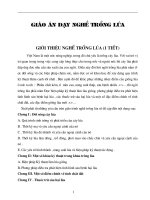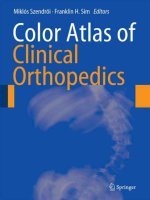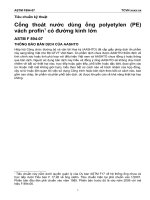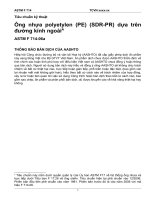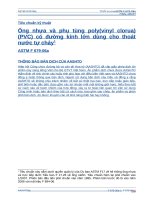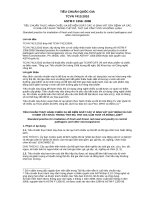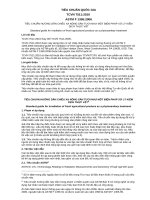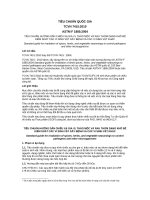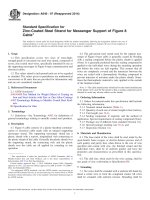Astm f 1816 97 (2009)
Bạn đang xem bản rút gọn của tài liệu. Xem và tải ngay bản đầy đủ của tài liệu tại đây (62.57 KB, 2 trang )
Designation: F1816 − 97 (Reapproved 2009)
Standard Safety Specification for
Drawstrings on Children’s Upper Outerwear1
This standard is issued under the fixed designation F1816; the number immediately following the designation indicates the year of
original adoption or, in the case of revision, the year of last revision. A number in parentheses indicates the year of last reapproval. A
superscript epsilon (´) indicates an editorial change since the last revision or reapproval.
INTRODUCTION
Knots, toggles, and other decorative or functional attachments on the ends of long, loose
drawstrings can catch and snag on other objects. Two hazards associated with such drawstrings on
children’s upper outerwear have been identified: the potential strangulation hazard associated
primarily with hood and neck area drawstrings of upper outerwear; the potential vehicular dragging
hazard associated primarily with waist and bottom drawstrings of upper outerwear. This consumer
safety specification is intended to reduce the risk of drawstrings on children’s upper outwear accessing
and getting snagged in various entrapment areas.
1. Scope
3. Terminology
1.1 This specification covers and is intended to reduce
strangulation and vehicular dragging hazards associated with
drawstrings on children’s upper outerwear.
3.1 Definitions of Terms Specific to This Standard:
3.1.1 bartack, n—the stitching through the drawstring and
channel usually at the back center of the channel to prevent the
drawstring’s being pulled through its channel.
1.2 The type of clothing covered by this specification is
girls’ and boys’ clothing, such as jackets and sweatshirts,
generally intended to be worn on the exterior of other clothing.
3.1.2 bottom of upper outerwear, n—the edge that circumscribes the lowest part of the garment (most distant from the
neck area).
1.3 The sizes covered by this specification are sizes 2T to 12
for neck/hood drawstrings and sizes 2T to 16 for waist/bottom
drawstrings.
3.1.3 drawstring, n—a non-retractable cord, ribbon, or tape
of any material to pull together parts of upper outerwear to
provide for closure.
1.4 Upper outerwear with fully retractable drawstrings are
exempt.
3.1.4 hood, n—a loose, pliable covering for the head, either
detachable or permanently attached to upper outerwear.
1.5 The values stated in inch-pound units are to be regarded
as standard. The values given in parentheses are mathematical
conversions to SI units that are provided for information only
and are not considered standard.
3.1.5 neck area, n—the area 1 in. (25 mm) above or below
the neck opening.
3.1.6 neck opening, n—the opening is defined by the seam
between the body of the upper outerwear and the collar or
hood.
2. Referenced Documents
3.1.7 toggle, n—the wooden, plastic, metal or otherwisecomposed piece attached to the loose end of the drawstring for
decorative purposes or to prevent the drawstring’s being drawn
through its channel.
2.1 ASTM Standards:2
D5219 Terminology Relating to Body Dimensions for Apparel Sizing
3.1.8 upper outerwear, n—clothing, such as jackets and
sweatshirts, generally intended to be worn on the exterior of
other garments.
1
This specification is under the jurisdiction of ASTM Committee F15 on
Consumer Products and is the direct responsibility of Subcommittee F15.37 on
Drawstrings for Children’s Clothing.
Current edition approved Dec. 15, 2009. Published April 2010. Originally
approved in 1997. Last previous edition approved in 2004 as F1816 – 97 (2004).
DOI: 10.1520/F1816-97R09.
2
For referenced ASTM standards, visit the ASTM website, www.astm.org, or
contact ASTM Customer Service at For Annual Book of ASTM
Standards volume information, refer to the standard’s Document Summary page on
the ASTM website.
3.1.9 waist, n—the narrowed part of the body between the
chest and hips (see Terminology D5219).
4. Performance Requirements
4.1 There shall be no drawstrings in the hood and neck area
of children’s upper outerwear sizes 2T to 12.
Copyright © ASTM International, 100 Barr Harbor Drive, PO Box C700, West Conshohocken, PA 19428-2959. United States
1
F1816 − 97 (2009)
4.2 Drawstrings at the waist and bottom of children’s upper
outwear sizes 2T to 16 shall:
4.2.1 Not exceed 3 in. (75 mm) in length outside the
drawstring channel when the garment is expanded to its fullest
width,
4.2.2 Have no toggles, knots, or other attachments at the
free ends, and
4.2.3 Be bartacked, if the drawstring is one continuous
string (see 3.1.6).
5. Keywords
5.1 children’s clothing; drawstrings
APPENDIX
(Nonmandatory Information)
X1. RATIONALE
X1.1 Potential Strangulation Hazard—From January 1985
to June 1995, the U.S. Consumer Product Safety Commission
received 42 reports, including 12 deaths, in which primarily
hood and neck drawstrings caught on playground equipment,
cribs, a fence, an escalator, or farm machinery, resulting in
actual or near strangulation. Victims ranged in age from 14
months to 8 years. The majority of the cases involved playground slides. Typically, as the child descended the slide, a
drawstring dropped into a gap between slide components, for
example, between the slide and platform, between the slide and
tunnel cover, between segments of a spiral slide, and so forth.
The drawstring pulled through the gap to the point where the
toggle or knot on the end caused it to snag. As a result, the child
was suspended part way down the slide, with the garment and
drawstring taut at the neck, strangling the child.
X1.2 Vehicular Dragging Hazard—From 1991 to 1996, the
U.S. Consumer Product Safety Commission received report of
12 incidents, including 4 deaths, in which waist and bottom
drawstrings snagged on school bus handrails or in schoolbus
doors. Typically, as the child descended the steps to get off the
bus, the drawstring dropped into a gap in the handrail. Before
the child or driver realized that the drawstring was snagged, the
bus door had closed and the bus was driving away, dragging
the child. Fatalities usually involved the child’s being run over
by the bus. Victims ranged in age from 7 to 14 years.
ASTM International takes no position respecting the validity of any patent rights asserted in connection with any item mentioned
in this standard. Users of this standard are expressly advised that determination of the validity of any such patent rights, and the risk
of infringement of such rights, are entirely their own responsibility.
This standard is subject to revision at any time by the responsible technical committee and must be reviewed every five years and
if not revised, either reapproved or withdrawn. Your comments are invited either for revision of this standard or for additional standards
and should be addressed to ASTM International Headquarters. Your comments will receive careful consideration at a meeting of the
responsible technical committee, which you may attend. If you feel that your comments have not received a fair hearing you should
make your views known to the ASTM Committee on Standards, at the address shown below.
This standard is copyrighted by ASTM International, 100 Barr Harbor Drive, PO Box C700, West Conshohocken, PA 19428-2959,
United States. Individual reprints (single or multiple copies) of this standard may be obtained by contacting ASTM at the above
address or at 610-832-9585 (phone), 610-832-9555 (fax), or (e-mail); or through the ASTM website
(www.astm.org). Permission rights to photocopy the standard may also be secured from the ASTM website (www.astm.org/
COPYRIGHT/).
2
